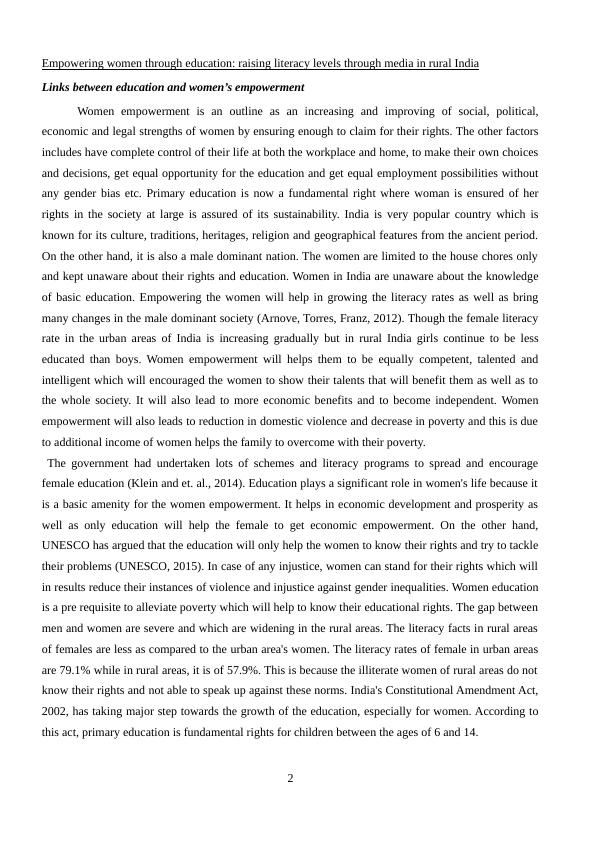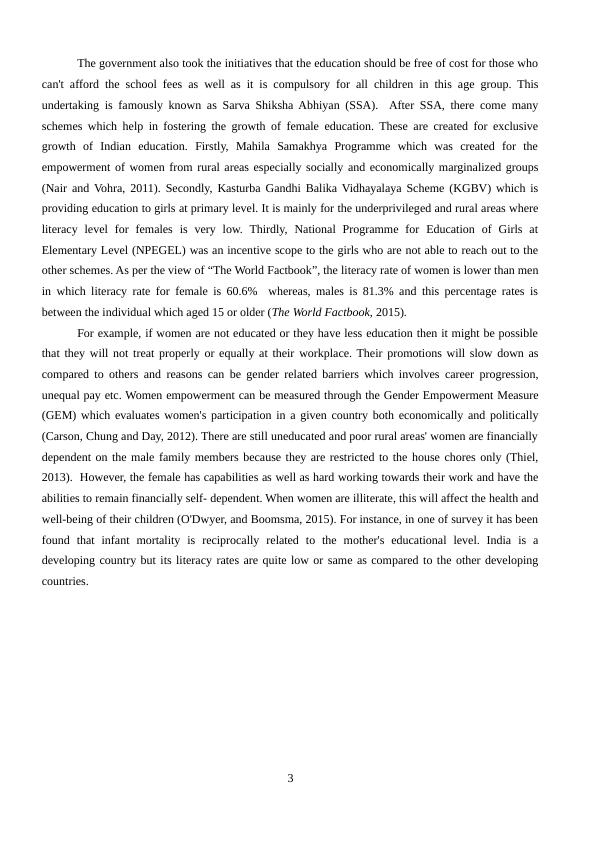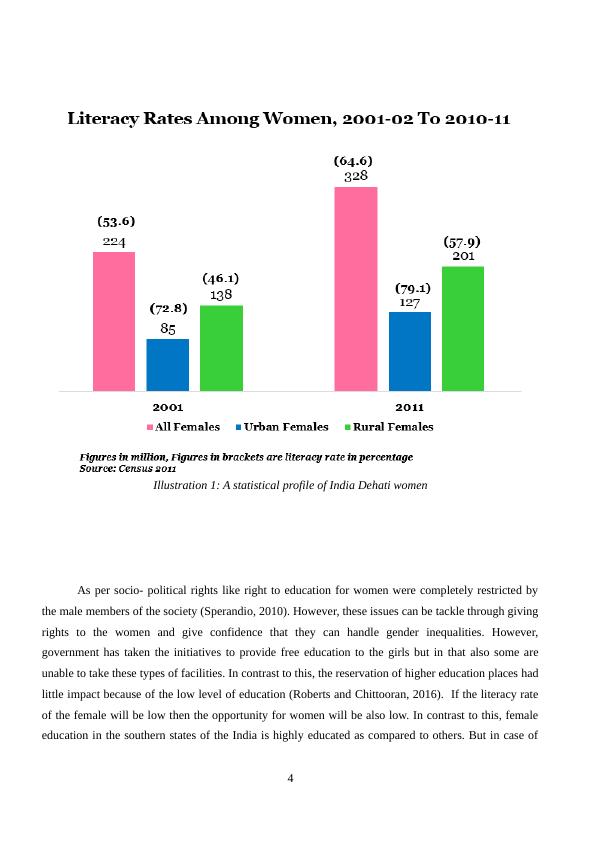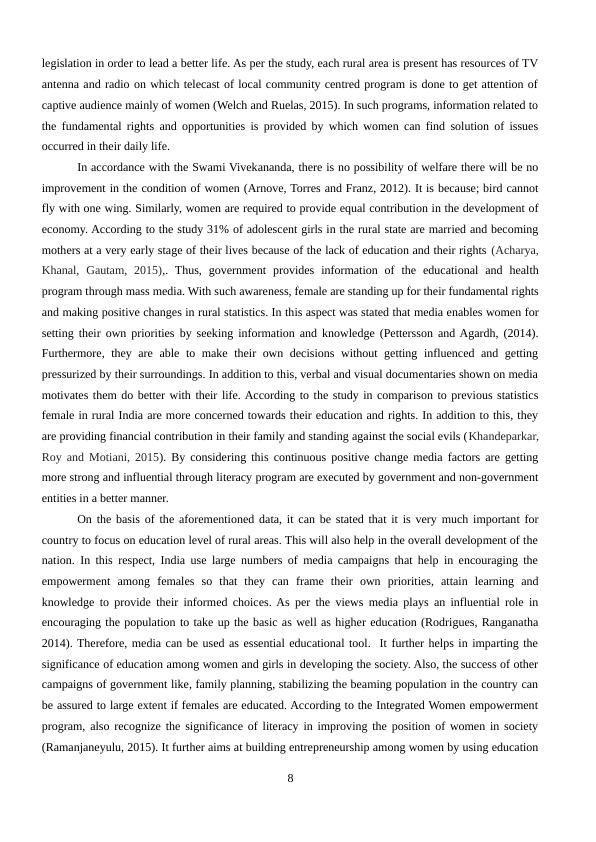Education and women empowerment in india
Added on 2020-02-14
49 Pages18255 Words146 Views
Literature Review1

Empowering women through education: raising literacy levels through media in rural IndiaLinks between education and women’s empowermentWomen empowerment is an outline as an increasing and improving of social, political,economic and legal strengths of women by ensuring enough to claim for their rights. The other factorsincludes have complete control of their life at both the workplace and home, to make their own choicesand decisions, get equal opportunity for the education and get equal employment possibilities withoutany gender bias etc. Primary education is now a fundamental right where woman is ensured of herrights in the society at large is assured of its sustainability. India is very popular country which isknown for its culture, traditions, heritages, religion and geographical features from the ancient period.On the other hand, it is also a male dominant nation. The women are limited to the house chores onlyand kept unaware about their rights and education. Women in India are unaware about the knowledgeof basic education. Empowering the women will help in growing the literacy rates as well as bringmany changes in the male dominant society (Arnove, Torres, Franz, 2012). Though the female literacyrate in the urban areas of India is increasing gradually but in rural India girls continue to be lesseducated than boys. Women empowerment will helps them to be equally competent, talented andintelligent which will encouraged the women to show their talents that will benefit them as well as tothe whole society. It will also lead to more economic benefits and to become independent. Womenempowerment will also leads to reduction in domestic violence and decrease in poverty and this is dueto additional income of women helps the family to overcome with their poverty.The government had undertaken lots of schemes and literacy programs to spread and encouragefemale education (Klein and et. al., 2014). Education plays a significant role in women's life because itis a basic amenity for the women empowerment. It helps in economic development and prosperity aswell as only education will help the female to get economic empowerment. On the other hand,UNESCO has argued that the education will only help the women to know their rights and try to tackletheir problems (UNESCO, 2015). In case of any injustice, women can stand for their rights which willin results reduce their instances of violence and injustice against gender inequalities. Women educationis a pre requisite to alleviate poverty which will help to know their educational rights. The gap betweenmen and women are severe and which are widening in the rural areas. The literacy facts in rural areasof females are less as compared to the urban area's women. The literacy rates of female in urban areasare 79.1% while in rural areas, it is of 57.9%. This is because the illiterate women of rural areas do notknow their rights and not able to speak up against these norms. India's Constitutional Amendment Act,2002, has taking major step towards the growth of the education, especially for women. According tothis act, primary education is fundamental rights for children between the ages of 6 and 14.2

The government also took the initiatives that the education should be free of cost for those whocan't afford the school fees as well as it is compulsory for all children in this age group. Thisundertaking is famously known as Sarva Shiksha Abhiyan (SSA). After SSA, there come manyschemes which help in fostering the growth of female education. These are created for exclusivegrowth of Indian education. Firstly, Mahila Samakhya Programme which was created for theempowerment of women from rural areas especially socially and economically marginalized groups(Nair and Vohra, 2011). Secondly, Kasturba Gandhi Balika Vidhayalaya Scheme (KGBV) which isproviding education to girls at primary level. It is mainly for the underprivileged and rural areas whereliteracy level for females is very low. Thirdly, National Programme for Education of Girls atElementary Level (NPEGEL) was an incentive scope to the girls who are not able to reach out to theother schemes. As per the view of “The World Factbook”, the literacy rate of women is lower than menin which literacy rate for female is 60.6% whereas, males is 81.3% and this percentage rates isbetween the individual which aged 15 or older (The World Factbook, 2015).For example, if women are not educated or they have less education then it might be possiblethat they will not treat properly or equally at their workplace. Their promotions will slow down ascompared to others and reasons can be gender related barriers which involves career progression,unequal pay etc. Women empowerment can be measured through the Gender Empowerment Measure(GEM) which evaluates women's participation in a given country both economically and politically(Carson, Chung and Day, 2012). There are still uneducated and poor rural areas' women are financiallydependent on the male family members because they are restricted to the house chores only (Thiel,2013). However, the female has capabilities as well as hard working towards their work and have theabilities to remain financially self- dependent. When women are illiterate, this will affect the health andwell-being of their children (O'Dwyer, and Boomsma, 2015). For instance, in one of survey it has beenfound that infant mortality is reciprocally related to the mother's educational level. India is adeveloping country but its literacy rates are quite low or same as compared to the other developingcountries.3

As per socio- political rights like right to education for women were completely restricted bythe male members of the society (Sperandio, 2010). However, these issues can be tackle through givingrights to the women and give confidence that they can handle gender inequalities. However,government has taken the initiatives to provide free education to the girls but in that also some areunable to take these types of facilities. In contrast to this, the reservation of higher education places hadlittle impact because of the low level of education (Roberts and Chittooran, 2016). If the literacy rateof the female will be low then the opportunity for women will be also low. In contrast to this, femaleeducation in the southern states of the India is highly educated as compared to others. But in case of4Illustration 1: A statistical profile of India Dehati women

rich states like Haryana and Punjab has lower literacy rates as compared to the Kerala and Tamil Nadu.This is due to the success of the government's initiatives to co-operate with the society and educate thewomen without any gender in equalities. Socialization of the girl child in India has a certain norms inwhich she has been trapped by the cultures of the patriarchy and hierarchy. Education is the key aspectfor the females which in India is still lagging behind their male counterpart. As per the data, girl drop-out ratio is increasing because with the extension of in the level of education.Parents of girls think that investing money in the schooling of girls will not benefit thembecause this broadly social in nature and these leads gender differentials (Niswade, 2015). In contrastto this,in rural areas, there is a problem that school is situated at a long distance and for that the girlshave to travel from place to another for long time. Due to this, parents don't allow their daughter totravel long distance from one place to another because of their safety. The socio-cultural factors playsan important role because it influence the parent’s choice due to that they choose the schools whereonly girls are admitted or where only women teachers are employed. In rural areas, girls are married atsmall age which restricted from the educational facilities and after marriage they look after theirfamilies. On the other hand, families put home chores burden on the girls at very small age throughwhich they are unable to attend the school. There is no safety measures been taken by the governmentso that girls are able to take education despite of free education is available by the government (Kumar,Basavaraja and Gagendra, 2014). The constitution of India grant the equality to women in the societyjust like male but the backward society can't take help from them. Empowering women should be thecrucial motto for the development of the country but India has been unable to reveal that significance.However, it can be critically assessed that women need to be empowered rather than treated as ahelpless victim of male chauvinism. The nation should provide respect and value to the women andthey should aware of their rights. India needs to take some crucial step to improve women position insociety by getting higher education (The Global Gender Gap Index).The real meaning of the women empowerment is to make them well educated and leave themindependent by which they will be able to take decisions on their own (Prakash, 2011). Genderdiscrimination in the country is bringing cultural, social, educational, economical differences whichwill decrease the country's development. In many backward areas, there is a trend of early marriageand childbirth because of the poverty, insecurity and illiteracy of the parents. In order to empowerwomen, various steps have been taken by the government to prevent violence, gender discriminationand abuse against women. Various mass campaign need to be organize in the rural areas which willmake them aware of the values of women and all the facilities which are available by the government.Women empowerment should take the high speed in India to equalize the women and men. Womenempowerment has the power which can change the society norms and values (Narang, 2011). They are5

fully able to tackle the economic conditions of the family and country through proper educationqualifications. In the recent years, several constitutional and legal rights have been enforced by thegovernment of India in order to reduced ill practices and gender discrimination against women.Modern societies are bringing awareness through print and electronic media to reach out to peoplewhich are helping the female literacy in India. This results in the increasing of the various self-helpgroups , NGOs etc. which are working in the women direction. In order to bring women empowermentin the Indian society, it needs to understand and reduce the main cause of the ill practices againstwomen which are patriarchal and male dominated system of the society (Das and Shah, 2014). It needsto be open-minded and change the old mind set against women together with the law and other legalprovisions. Factors by which women excluded from basic education in IndiaIndia is taking severe steps towards women's status and education. There are some acts whichare created by the country to improve the quality of education. The main reason for not allowingwomen for education is the gender inequality through this discrimination; women are subjected to theeducational differences (Goli and Pou, 2014). The chief barriers to female education in India areinadequate school facilities such as sanitary facilities, shortage of female teachers and gender bias inthe curriculum. Gender bias, here, meant as the female characters being depicted as weak helpless.Despite of this, women constitute half power of the nation and have the rights to change theinequalities in the society (Roy and Tisdell, 2002). There are various challenges by which women areexcluded from the basic education in India. One of the challenges is poverty in the rural India due tothat the family can't afford the school fees through which some girls are unable to take education. Theforemost reason can be the way parents perceive the female education. For instance, if a family has tochoose between educating a son or a daughter because of financial limitation then surely the son willbe selected. This is because negative parental attitudes towards educating daughters can also be abarrier to a girl’s education. One of the reasons can be caste which old age discrimination in which richpeople or upper class can only take education because they are capable of it which is false (Joseph,2013). The lack of the infrastructure in the schools can also be the reason for the women to not takeany education.Due to poverty which barricades the female to stop taking education in rural India which ishappening through continuing the debt loans taking from the money lenders. In India, males havethinking that women are born only to care of the family and house chores. Due to this discriminationwomen are not allowed to take up education. This mentality is carried out generation by generation thatare degrading the position of women in the society. The rural area's women are not taking any majorstep against this, through which men of the rural society is neglecting their importance. The overall6

reason for this issue is gender inequalities which are making the situation worse and if any women takeany measures against it then they are treated badly by their family and society (Chhokar, 2010). This isbecause they have set some unethical norms for the women to be not educated and remain limited tothe house only. Government has now created some programmes to improve education and economicopportunities for women which will provide more equitable development which will results in bettereconomy situation in the country. Role of Media in promoting women literacy in rural India There are various studies that reveal that there is broad gender difference in the literacy rate inIndia. The females of the country are not provided proper basic as well as higher education. Thestatistics disclose that, India is presently having the highest number of illiterate population. As per thedata generated through Census 2011, total literacy rate in India is 73.0% consisting of 64.6% femalesand 80.9% males (Literacy rate in India, 2015). However, the literacy rate in rural areas is much lowerthan that of urban areas. The recent survey conducted by NSSO (National sample survey office) it hasbeen identified that literacy rate is 71% in rural parts of India in contrast to 86% in urban parts for theage group of 7 years and above. Furthermore, the adult literacy rate which comprises of age group of15 years and above is also low in rural areas. The report states that only 64% of adults are literate inrural areas in comparison to 84% in urban parts (Report of NSSO, 2015). The major reason of lack ofeducation among females in rural areas is due to gender based equality. In addition to this, majority ofthe rural population is living life of stereotype that believes that women are for handling domesticchores. Thereafter, social discrimination and economic exploitation are also some reason that areresponsible for poor female literacy rate. Rural India is signatory to the NFLS (Nairobi Forward Looking Strategy) and CEDAW (Conventionon Elimination of Discrimination Against women) 1995 in which top priority is provided to the femaleliteracy through the communication media (Carilli and Campbell, 2012). In present era, mass media isplaying vital role in developing environmental awareness and information in rural India. Due to costeffectiveness and appeal factor mass media is used globally in order to disseminate information. Massmedia can ensure participation of rural women in economic, social and political processes. In thisaspect states that the mass media has the potential for providing information, inspiration, andinstruction for rural women through which they can get aware about their rights and responsibilities(Ames, Burcon, 2011)In the rural India, TV & radio had assisted in the social transformation through promotion ofempowerment by the efforts of both government and non-government organisations. The regionallanguage media is powerful and pervasive through women can think different from their rural life(Anca and Gabaldon, 2014). Furthermore, they can avail opportunities provided by the government and7

legislation in order to lead a better life. As per the study, each rural area is present has resources of TVantenna and radio on which telecast of local community centred program is done to get attention ofcaptive audience mainly of women (Welch and Ruelas, 2015). In such programs, information related tothe fundamental rights and opportunities is provided by which women can find solution of issuesoccurred in their daily life. In accordance with the Swami Vivekananda, there is no possibility of welfare there will be noimprovement in the condition of women (Arnove, Torres and Franz, 2012). It is because; bird cannotfly with one wing. Similarly, women are required to provide equal contribution in the development ofeconomy. According to the study 31% of adolescent girls in the rural state are married and becomingmothers at a very early stage of their lives because of the lack of education and their rights (Acharya,Khanal, Gautam, 2015),. Thus, government provides information of the educational and healthprogram through mass media. With such awareness, female are standing up for their fundamental rightsand making positive changes in rural statistics. In this aspect was stated that media enables women forsetting their own priorities by seeking information and knowledge (Pettersson and Agardh, (2014).Furthermore, they are able to make their own decisions without getting influenced and gettingpressurized by their surroundings. In addition to this, verbal and visual documentaries shown on mediamotivates them do better with their life. According to the study in comparison to previous statisticsfemale in rural India are more concerned towards their education and rights. In addition to this, theyare providing financial contribution in their family and standing against the social evils (Khandeparkar,Roy and Motiani, 2015). By considering this continuous positive change media factors are gettingmore strong and influential through literacy program are executed by government and non-governmententities in a better manner. On the basis of the aforementioned data, it can be stated that it is very much important forcountry to focus on education level of rural areas. This will also help in the overall development of thenation. In this respect, India use large numbers of media campaigns that help in encouraging theempowerment among females so that they can frame their own priorities, attain learning andknowledge to provide their informed choices. As per the views media plays an influential role inencouraging the population to take up the basic as well as higher education (Rodrigues, Ranganatha2014). Therefore, media can be used as essential educational tool. It further helps in imparting thesignificance of education among women and girls in developing the society. Also, the success of othercampaigns of government like, family planning, stabilizing the beaming population in the country canbe assured to large extent if females are educated. According to the Integrated Women empowermentprogram, also recognize the significance of literacy in improving the position of women in society(Ramanjaneyulu, 2015). It further aims at building entrepreneurship among women by using education8

End of preview
Want to access all the pages? Upload your documents or become a member.
Related Documents
Policy Brief on Gender Equality – The Case of Indialg...
|13
|3780
|63
(PDF) Gender Inequality in Bangladeshlg...
|11
|330
|190
The Social Impact of Inequality on Gender: Mental Health, Education, and Employmentlg...
|10
|2584
|363
A Comparative Study on Gender Equality in Educational Institutionslg...
|14
|4312
|25
Essay on Women Empowerment Assignment 2022lg...
|4
|668
|18
gender equality and women's empowerment in africalg...
|5
|1149
|484
